| This is a view of the main entrance to the NAMM Show. I found it interesting that there was a fundamentalist Christian group picketing the show. This is one of the same groups that comes to the Tournament of Roses Parade each New Years Day in Pasadena. I suppose they feel Musicians are mostly heavy sinners – and perhaps they are correct! |
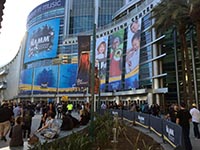 |
| 2015 will likely go down as the year that manufacturers perfected the plastic brass instrument. There were tons of these at the show. I particularly liked the trumpets developed by Tromba - enough so that I bought one. I bought this silver colored C trumpet. It fills a gap in my trumpet collection, and because it "looks" like a metal trumpet, I can probably get by on serious gigs with it. The designer, George Schlub, was at the booth and I had a fascinating discussion with him. He even showed me some amazing "real" brass instruments he had designed that were fantastic. |
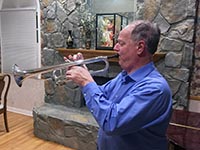 |
| But not all that is plastic is at this level. This tuba, by another manufacturer, was interesting for its sheer size. However, it did not play nearly as well as the trumpets mentioned above. |
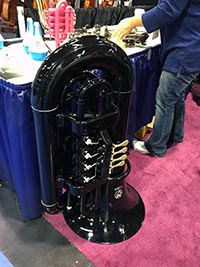 |
| Here is a display of plastic flutes that all played very well. The ones on the left are piccolos and the ones on the left are flutes. The ones in the middle, which caught my eye, are pitched in G in between! I had never seen this size flute in any material before. |
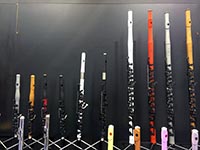 |
| These are plastic reeds (for alto sax) - which is nothing particularly new. However, this exhibitor found reed cases that had been designed to interface to the Lego building system! You could not buy the Lego case separately, and they did not have sopronino sax reeds, so I passed on this one. |
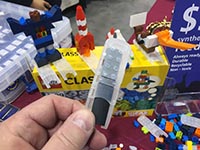 |
| Over the years, the number of real organs on display at the show has dwindled. However, Rodgers Instruments was back this yea with a small display that included this interesting new console style. It is based on French consoles by Cavaille Coll and is quit impressive. Of course, it takes up considerable more width in a room! |
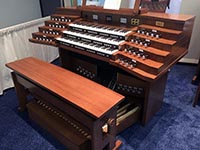 |
| Although this looks like an organ - it actually is not. This is a wooden stand,, built in the general shape of a Hammond organ console, designed to hold two Nord synthesizer keyboards and a Nord pedal MIDI controller. It appears to be an attempt by Nord to get into the church market. Without a bench, I could not actually try this to see if it plays like an organ. |
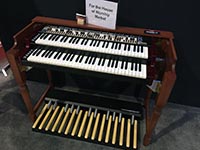 |
| Here is what looks like an ARP Odyssey, one of the classic analog synthesizers from the 70s. However, on closer inspection, it is a bit too small. It is, in fact, a Korg reproduction of the Odyssey built to 86% scale. Korg worked with Alan R. Pearlman and David Friend, who were the people behind the original ARP, to produce this. It tried it and it plays like the real thing. |
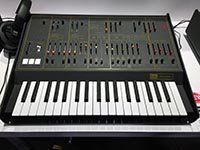 |
| Here is something I haven't seen in a while – a major company (Korg) manufacturing kits. You can buy these kits to assemble your own custom synthesizer. |
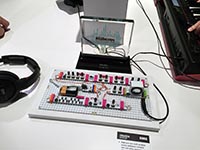 |
| And speaking of kits, there were an abundance of modular analog synthesizer manufacturers at NAMM this year. This is in the Moog exhibit. As the sign says, they are building a patch for a demonstration. This is very authentic, as I did not have time to wait for the patch to be completed! |
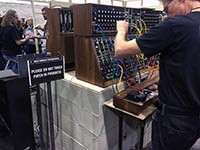 |
| Here is a new instrument. It is a sort-of hand-held steel drum that you play in your lap. Its turned like a steel drum. This model is diatonic but they also make chromatic ones. It is a company called Hang-Music and they call this the "hang drum." It was quite fun to play. |
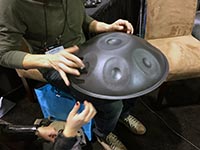 |
| This is the Slaperoo, a percussion instrument with a metal ribbon running along its length. You finger the ribbon to change the resonant frequency and tap (or hit in any other way) the ribbon to excite it. Basically, it plays like a one-string bass and if really cool. It has a wide range of interesting sounds - but it can also be played like a jazz bass. |
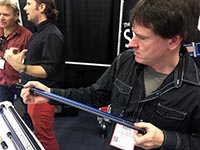 |
| These two folks are playing Theremins that are built into Matryoshkas, Russian nesting dolls. These dolls actually do not nest but simply form an interesting case for the Theremin. They were playing in harmony and in time with a recorded accompaniment. When they finished a tune, I spoke with the man. He introduced himself as a "Japanese professional Theremin player." The stethoscopes they are wearing are simply to help them hear the instruments, which are actually quite quiet. |
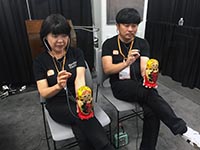 |
| There have been electronic (MIDI) drums at NAMM for decades. This year, I saw several companies using a new line of Zilgian cymbals designed for use with electronic drum sets. They are designed to have very little acoustic sound. However, you can play them like real cymbals, with all the intricacies of getting different sounds depending on where and how you strike them. This makes playing electronic drums much more enjoyable. |
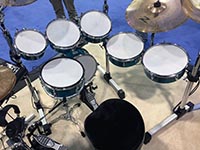 |
| Of course, the look of your amplifiers is also critical. Here are some interesting speaker cabinets with various colored light displays! |
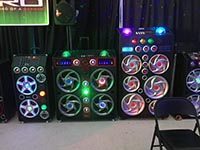 |
| Though this is not a musical instrument,. I found it fascinating. It is a company that uses 3D printing to create the perfect earpod (in-the-ear headphone device) for each individual. They scan your ear canal to create a 3D model of the space available and then print the case for the earpod to fit exactly. |
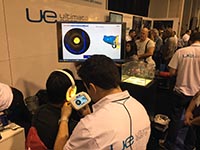 |